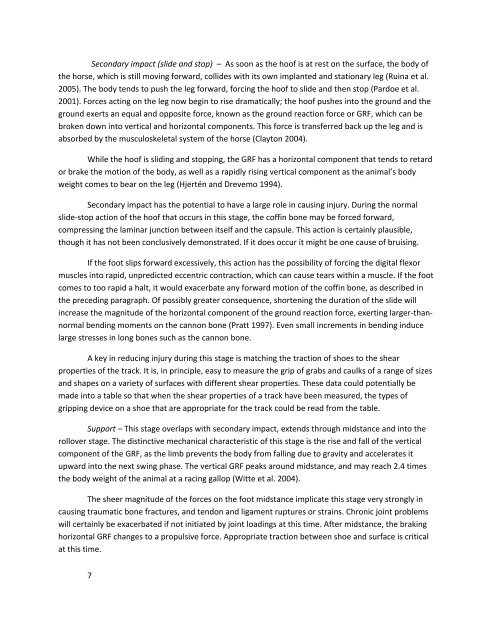Retired Racehorses
tfrr_reportandappendicesfinal
tfrr_reportandappendicesfinal
- No tags were found...
You also want an ePaper? Increase the reach of your titles
YUMPU automatically turns print PDFs into web optimized ePapers that Google loves.
Secondary impact (slide and stop) – As soon as the hoof is at rest on the surface, the body of<br />
the horse, which is still moving forward, collides with its own implanted and stationary leg (Ruina et al.<br />
2005). The body tends to push the leg forward, forcing the hoof to slide and then stop (Pardoe et al.<br />
2001). Forces acting on the leg now begin to rise dramatically; the hoof pushes into the ground and the<br />
ground exerts an equal and opposite force, known as the ground reaction force or GRF, which can be<br />
broken down into vertical and horizontal components. This force is transferred back up the leg and is<br />
absorbed by the musculoskeletal system of the horse (Clayton 2004).<br />
While the hoof is sliding and stopping, the GRF has a horizontal component that tends to retard<br />
or brake the motion of the body, as well as a rapidly rising vertical component as the animal’s body<br />
weight comes to bear on the leg (Hjertén and Drevemo 1994).<br />
Secondary impact has the potential to have a large role in causing injury. During the normal<br />
slide‐stop action of the hoof that occurs in this stage, the coffin bone may be forced forward,<br />
compressing the laminar junction between itself and the capsule. This action is certainly plausible,<br />
though it has not been conclusively demonstrated. If it does occur it might be one cause of bruising.<br />
If the foot slips forward excessively, this action has the possibility of forcing the digital flexor<br />
muscles into rapid, unpredicted eccentric contraction, which can cause tears within a muscle. If the foot<br />
comes to too rapid a halt, it would exacerbate any forward motion of the coffin bone, as described in<br />
the preceding paragraph. Of possibly greater consequence, shortening the duration of the slide will<br />
increase the magnitude of the horizontal component of the ground reaction force, exerting larger‐thannormal<br />
bending moments on the cannon bone (Pratt 1997). Even small increments in bending induce<br />
large stresses in long bones such as the cannon bone.<br />
A key in reducing injury during this stage is matching the traction of shoes to the shear<br />
properties of the track. It is, in principle, easy to measure the grip of grabs and caulks of a range of sizes<br />
and shapes on a variety of surfaces with different shear properties. These data could potentially be<br />
made into a table so that when the shear properties of a track have been measured, the types of<br />
gripping device on a shoe that are appropriate for the track could be read from the table.<br />
Support – This stage overlaps with secondary impact, extends through midstance and into the<br />
rollover stage. The distinctive mechanical characteristic of this stage is the rise and fall of the vertical<br />
component of the GRF, as the limb prevents the body from falling due to gravity and accelerates it<br />
upward into the next swing phase. The vertical GRF peaks around midstance, and may reach 2.4 times<br />
the body weight of the animal at a racing gallop (Witte et al. 2004).<br />
The sheer magnitude of the forces on the foot midstance implicate this stage very strongly in<br />
causing traumatic bone fractures, and tendon and ligament ruptures or strains. Chronic joint problems<br />
will certainly be exacerbated if not initiated by joint loadings at this time. After midstance, the braking<br />
horizontal GRF changes to a propulsive force. Appropriate traction between shoe and surface is critical<br />
at this time.<br />
7


